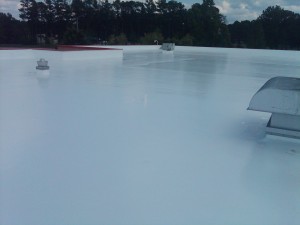Is Silicone the Last Roof You’ll Ever Need?
Silicone is quickly becoming the go to material in the flat roof coatings market. Its benefits range from leak-free protection to improved aesthetic appeal of the roof to improved sustainability. When a silicone roof coating is installed, it is there for performance. These roofs are also highly sustainable, and could quite literally be the last roofing substrate you ever need with only a recoating every 10-15 years. Check out this video that illustrates the ease of application of silicone flat roof coatings: Roof Coating Restoration.

The Benefits of Silicone as a Flat Roof Coating
Let’s look at the benefits of silicone as a flat roof coating. What does it do that no other material can? First, it withstands ponding water – indefinitely. Because silicone coatings are not water based like acrylic, they absorb no moisture. While some acrylic coatings can be reinforced with fabric to withstand a little ponding water, they are no match for silicone’s natural resistance to moisture.
Another benefit to silicone is that it doesn’t chalk off as other flat roof coatings do. Silicone is “Non-sacrificial”, and as such it doesn’t slowly shed as time goes by. It will stay fully intact for the life of the roof. Thirdly, silicone doesn’t need to be reinforced with roof fabric, saving you time and money on installation. The last major benefit to silicone is that you need less of it than most other flat roof coatings. As little as 2 gallons can be used for 100 square feet, less than half that would be needed for acrylic.
Things to Watch Out For
Silicone can be very slippery when wet. Because it resists water, the surface becomes very slippery at the first sign of water. Be careful. Another warning is that the coating must be applied to a completely dry roof. If there is any moisture on the surface, it can compromise the adhesion of the silicone to the roof.
While silicone doesn’t normally require multiple coats or reinforcing tape, there are certain instances where you want to use each of these. If you have a dry cap sheet roof, you probably want to apply a silicone base coat, then another coat of silicone on top of that. Also, if you find any loose seams, you want to reinforce with tape or fabric prior to applying the coating.
